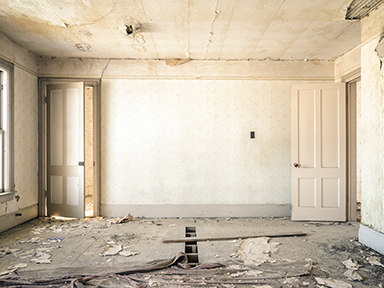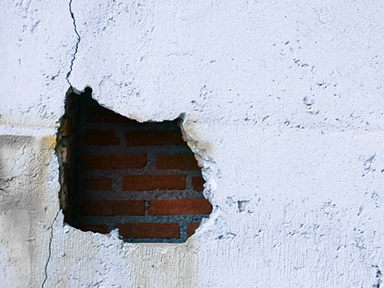When does a modification become damage and is it covered by insurance? Read on to find the answers…
In recent years, state and territory governments have been reforming tenancy legislation to make renting easier for tenants. Among the changes that have come into effect across most parts of the country, is allowing minor modifications to the premises. What constitutes a minor modification differs by jurisdiction, but generally includes things like installing child safety devices, putting up picture hooks to hang art, installing security cameras, painting, or planting a garden. In most cases, the landlord needs to give permission (and usually cannot reasonably refuse) but, in other cases, no permission is needed. Scroll down for a state-by-state overview.
With the changing legislation comes questions about whether modifications made to the rental are considered ‘damage’ and whether a claim can be made on the landlord’s insurance.
First, let’s look at who is responsible for damage
Regardless of the type of damage a tenant, their child, pet or guest has caused (be it accidental, malicious or intentional), the tenant is responsible for fixing it. Depending on the policy, landlord insurance can provide financial protection if the tenant does not make good on their obligation to repair damage they have caused. Insurance providers may cover the three types of damage mentioned, a combination, or no damage.
Now, let’s look at modifications
Before the legislation changed, any modification to the property generally needed landlord permission. It was usually solely at the landlord’s discretion if they would allow the modification to be made and whether the tenant was required to return the premises to its unmodified state on vacating.
If the landlord refused permission and the tenant went ahead and made the modification anyway or did not reinstate the property as agreed, it was generally considered tenant-related damage. The damage could range from the minor, such as picture hooks, to the major, such as re-painting the entire property (we once heard of someone painting the inside of a property black!).
Of course, if the landlord gave permission for the modification to be made and did not require reinstatement, then it would not be a case of intentional damage, and no claim could be made.
And now…
Legislation in some areas allows minor modifications to be made without landlord consent. Most legislation details what is considered a minor modification. Changes to the property outside of these guidelines, made without landlord permission and not removed, may be considered damage. For example, as we mentioned above, we knew of a tenant who painted the inside of a property black. If the tenant didn’t repaint the walls back to the original colour, this may be considered damage (unless the landlord is happy with the modification).
Damage – covered, not covered?
Whether damage is covered by insurance depends on the insurance provider and the policy. At EBM RentCover our RentCover Ultra and Platinum policy provide cover for accidental, malicious or deliberate damage up to $70,000.
Legislation concerning minor modifications can lead to confusion about what is considered damage and what is not (and whether you have a valid insurance claim). Get in touch with a member of EBM RentCover’s Expert Care team if your rental has suffered damage from your tenant making and leaving modifications in circumstances where they were obliged to reinstate the property to its pre-modified condition.
Modifications – a quick state-by-state summary
Queensland
Fixtures can only be added, and structural changes can only be made, with the property owner/manager’s written consent and they do not have to agree to the request if they give a good reason. The agreement should be in writing and specify what happens with the fixture once the tenancy ends.
New South Wales
Tenants can make changes of a ‘minor nature’. Tenants can install fixtures or make alterations, additions or renovations if they have the landlord’s written consent, or if the tenancy agreement permits. If the tenant’s request for a fixture or alteration, addition or renovation is of a ‘minor nature’ then the landlord must not unreasonably withhold consent. At the end of the tenancy, a tenant is responsible for making sure any alterations, additions or renovations are removed and for also fixing any damage caused to the property.
Australian Capital Territory
Tenants can make modifications with the landlord’s written permission. There are two categories of modification: general modification and special modifications. Special modifications include minor modifications and modifications for safety, security, disability, energy efficiency or telecommunications access. Landlords can refuse consent to special modifications (including minor modifications) only with the approval of the Tribunal. Landlords are able to refuse consent for general modifications only if it is reasonable for them to do so in the circumstances. The tenant must make sure the modifications are undone at the end of the tenancy unless the landlord agrees to the modifications remaining in place.
Victoria
Tenants can make modifications to the property, subject to conditions. Some changes do not require landlord consent, including some child safety measures, picture hooks (so long as the property is not heritage-listed) or temporary window treatments such as curtains. Reasonable changes do require permission, but the landlord cannot refuse permission without a good reason. The landlord can may require the tenant to pay an extra bond to cover the cost of undoing changes at the end of the rental agreement.
Tasmania
Tenants cannot make any alterations or additions, or add fixtures, without the written permission of the owner. At the end of the lease, the tenant is responsible for the removal costs of any unauthorised alterations, additions or added fixtures. At the time of writing, there was a proposed Bill which includes allowing minor modifications of a safety nature (e.g. to prevent furniture from toppling) to be made without landlord consent (so long as the modification would not cause permanent damage; if it would, landlord permission would be required but could not be unreasonably refused).
South Australia
Tenants can ask their landlord for permission to make minor alterations or safety modifications, as long as they do not affect the structure of the premises. Changes cannot be unreasonably refused for alterations or additions that relate to minor alterations or additions, reasonable changes necessary for disability assistance, or reasonable changes necessary for mobility or access needs relating to age. Anything added must be removed at the end of the tenancy, unless the landlord agrees for it to remain. Tenants are responsible for the repairs of any damage caused by the removal.
Western Australia
Tenants can make a rental property feel like a home by making changes, subject to conditions. Security changes can be made to prevent family violence so long as the landlord is notified in writing prior to the modifications being made (approval is not needed). Landlord permission is required before tenants can secure furniture to a wall for the safety of a child or a person with a disability. A tenant with a disability can make changes to help them access and use the home – landlord permission is required but cannot be refused if it is against the Equal Opportunity Act 1984 (WA) or Disability Discrimination Act 1992 (Cth). Tenants can make minor modifications with the landlord’s permission (refusal is only permitted for limited reasons). At the end of the tenancy, the tenant must remove the modification unless the landlord has agreed to keep it and repair any damage that the modification caused.
Northern Territory
Tenants require landlord permission to make safety or security modifications. Landlord permission cannot be unreasonably refused. The modification request must be made in writing and the landlord has 10 business days to grant or refuse the request (if the landlord does not respond to the request within the time frame, it is taken that the landlord has consented to the request). Tenants can make urgent safety or security modifications without the consent of the landlord if there is an immediate safety or security issue but must notify the landlord within two business days of the modifications being commenced. At the end of the tenancy, the premises must be returned to its original condition unless otherwise agreed between the parties.
*While we have taken care to ensure the information above is true and correct at the time of publication, changes in circumstances and legislation after the displayed date may impact the accuracy of this article. If you need us we are here, contact 1800 661 662 if you have any questions.
You may also like
View all
Damage is damage, right? Well, not when it comes to insurance...

When your rental suffers damage, some repairs are considered ‘urgent’ and must be completed within legislated timeframes. Here is the reason...

If your rental property is vandalised by someone who isn’t your tenant, here’s what you need to do...



